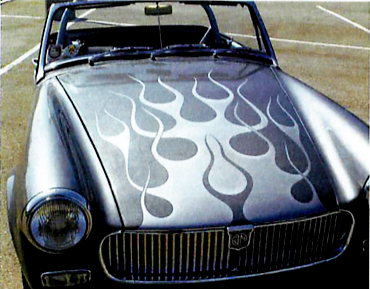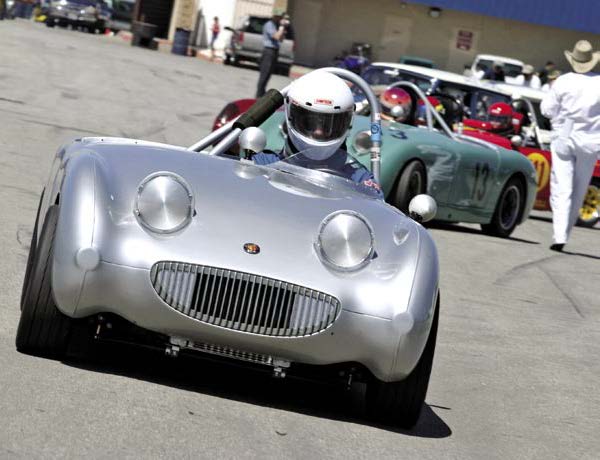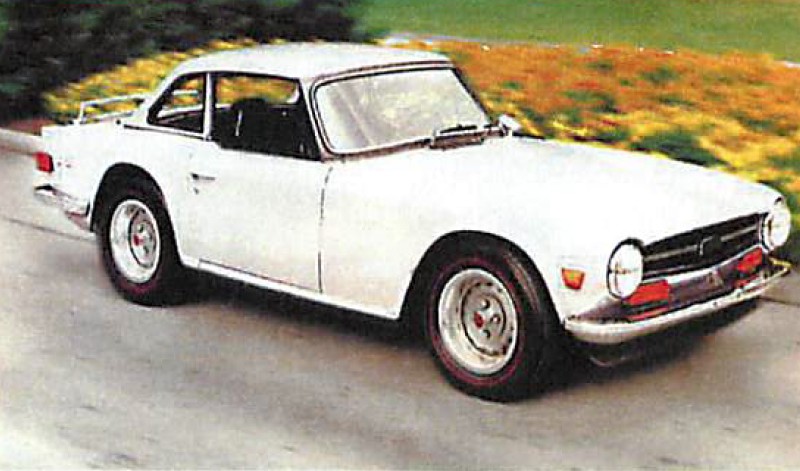If drivers match their cars, as owners match their dogs, then a glance at my MG midget clearly suggest that I wish to be an irresponsible teenager. Caring not a whit for safety, I am an immortal, screaming down the road with blaring exhaust, and my hair on fire. Please disregard the overweight, middle-aged man standing behind the curtain.
Screaming down the road requires the ability to scream. My parts-bin Midget, with an asthmatic old 1275, is more inclined to wheeze. What’s more, the auto industry’s ongoing horsepower wars have changed our perceptions of what constitutes power. After driving a four-door sedan with 300 horsepower and monster brakes, traditional notions of A-series tuning just won’t cut it. We need more power.
With the flaming Midget anything but original, it is obvious choice for a project-car status. All it needs is a fresh engine and we can begin to experiment with some exotic modifications. We each have our limits. I draw mine at engine swaps. The car can have a five-speed and Corvette brakes, just don’t go looking to drop a Miata motor in there. All it needs is a fresh engine…
Sometimes life intrudes so we jump ahead five or six years in the narrative. Way back when, I had given a 1275 lump to Tom Colby at Speedwell Engineering. The intent was to build a solid street motor, not a race motor. When the project started, I was enamored with the idea of fuel-injection. I still am, but there was also a double-secret desire for boost.
It came a surprise this spring, when Tom called out of the blue to tell me he’s worked his way to the bottom of the of the priority list and—finding my name there—is ready to start the engine build. In the intervening years, I’ve owned and enjoyed a fuel-injected classic Mini, so been-there-done-that. The Moss R&D department, fresh off the successful introduction of an MGB supercharger kit, is now casting about for another blower project. “Gosh, if we were to build a Spridget blower, we would need a development car,” says I.
Moss Motors was and is a supercharger company. Over the years, we’ve made a small fortune in blowers (having started with a large one). Back in the 1950s, company founder Al Moss imported British-made Shorrock superchargers for MG T-series cars. Somewhere around 1955 my father bought one for his TC. He still has the car and I still savor the time I spent as a teenager driving that machine. Compared to my first car—a two-cylinder, 600cc motorcycle-engine Honda—the TC was a real powerhouse.
Fast-forward another six months, and Spridget supercharger kits are on the shelf. The flaming silver Midget now spouts real flames. Dyno charts are fine for advertising, but they don’t convey the true driving experience. A supercharged Midget is more than just able to keep up with traffic: It’s the automotive equivalent of a no-see-’em buzzing around your ear. (Have to watch that—SUV tires are taller than the car.) It rocks, it bellows, it breaks parts, or it probably would if the inside rear tire would stay stuck under acceleration.
We could spend hours discussing the merits of various engine modifications. What I wanted was to see the effect of off-the-shelf parts on the blower installation. We advertise heads and cams and exhaust systems, etc. But will they make a difference? With the silver Midget, we were going to find out. The Speedwell engine is modified, but not to any crazy extent. The block is punched out to 1330cc. Although not strictly necessary, for the sake of surviving experimentation, we went with forged pistons. The head is an off-the-shelf alloy unit, and the cam is a Cooper S profile.
One of the great innovations for classic British sports cars is the the aluminum cylinder head. Although largely identical in design to the original iron part, aluminum runs much cooler than iron. This allows more aggressive ignition timing, or better resistance to detonation. An added bonus is weight reduction. While we’re on the aluminum kick, I also decided to install an aluminum flywheel.
The car had an old 3-into-l header, which stayed in place for the lime being. Once installed in the car, the engine received a Moss off-the-shelf Spridget blower kit. Initial tests showed that the extra displacement was robbing boost, so before heading down to the dyno, the R&D guys installed a smaller blower drive pulley. Results arc shown in the accompanying graph. The car felt last, but it was a real surprise when we learned that the jump from slock supercharged engine to modified supercharged engine was greater than from normally aspirated to supercharged.
Not long after posting results from the dyno session on the web, I got an e-mail from Sean Brown. Scan’s company, Flowspeed (www. flowspeed.com), specializes in MGB cylinder head modifications. There has been some online discussion on cylinder head and porting choices. Sean was interested in demonstrating the value of properly executed cylinder head work.
Now, the original intent o f the project was to demonstrate what one can achieve with relatively mundane parts, but you know how psychology works on a simple mind. If more is always better, and 100 rear-wheel horsepower is so tantalizingly close, why not have a go? Sean’s approach to modification is based on careful analysis of how air and fuel interact, and how they flow through the ports. Rather than just make everything as big as possible, Flowspeed concentrates on optimizing. It’s a subtle—but important- difference.
In any engine, power is limited by airflow. Based on experience with the MGB, we know thai the cylinder head is a limiting factor. In cleaning up the combustion chambers, we gained some volume and lost a little compression. Unfortunately, there
wasn’t enough meat left on the blower drive pulley to make another cut. With the print deadline looming, we ran out of time to make a new pulley and retune the motor. However, more air means more power*. Flowspeed’s results show an average increase of 7 cfm, so that magic 100 horse power is within sight.
The car I should have owned when I was eighteen is now the car I wouldn’t allow an eighteen-year-old to drive. When John Sprinzcl, of Sebring Sprite fame, drove the car, he said, “A nicer, tauter, easier-to-drive, and more powerful Sprite would be hard to find.” Kind words indeed. We can make a Spridget breathe fire, and be fast enough to out-run modern traffic. Now if we could just get it to stop…










'Mighty Midget: One Big Bad Blown Midget' has no comments
Be the first to comment this post!